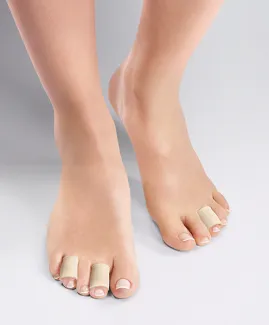Would you be able to explain the difference between a corn vs a wart? You may have not the answer. There’s nothing surprising, giving that both foot conditions have a number of similarities. However, there are even more ways to distinguish them. EPITACT® gives you some tips to make the difference between a corn versus a plantar wart.
Corns vs warts: some distinct causes
How do foot corns and warts develop?
A foot corn is a localised and thickened area of skin made of hard skin. It usually appears after excessive pressure on this small surface.
A wart is also a localised area of thickened and hard skin, but it is due to viral infection. Indeed, the formation of plantar warts is related to the human papillomavirus (HPV). There are several types of warts which are caused by different types of HPV. For example, the myrmecia is a deep, unique and painful wart which is caused by the HPV1. As for them, the mosaic warts are clusters of superficial and painless plantar warts caused by the HPV2. There are more than one hundred types of HPV in all!
The main difference between a plantar wart vs a corn then goes back to their origin. Corns have a mechanical cause linked with excessive pressure whereas warts have an infectious cause related to a virus.
Are they contagious?
It is well known that warts are very contagious. They usually spread from person-to-person through direct (skin to skin) or indirect (infected surfaces) contact. This explains why the transmission of plantar warts is higher in places requiring walking barefoot. Also note that hot and damp environments increase the contagiousness of the infection. On the contrary, foot corns are absolutely not contagious.
Symptoms of corns vs plantar warts
The signs and symptoms (appearance, location and pain) of a foot corn or a wart can be similar or very different.
What do they look like?
Corns on feet and warts both appear like thick and round-shaped hard skin excrescences.
The corn has a hard cone-shaped core pointing down into the skin that gradually penetrates the deep layers of skin.
Please note that a corn looks different whether it is a hard corn or a soft corn. The latter is caused by excessive pressure and maceration between two toes, hence the spongy texture. It has a whitish surface surrounded by reddish colouration, sign of inflammation. Lastly, its centre is marked with a black point.
The wart has a soft centre marked with multiple black dots delimited by a horny ring. The appearance can also vary from one type of wart from another. For example, mosaic warts are a cluster of small superficial warts. Myrmecias are the most frequent type of warts, usually unique but deeper.
Corn vs wart: where do they form?
The next difference is the location of a corn versus a plantar wart.
Corns form at points of hyperpressure on the foot, commonly at a bony protrusion. A hard corn develops on the top or tip of a toe but sometimes also under the forefoot. So, it can appear on top of a toe at a joint or on the ball of the foot at a metatarsal head. As for it, a soft corn appears between two toes. For this reason, it is sometimes called an ‘interdigital corn’.
A plantar wart doesn’t have precise location. Since it is due to viral infection, it can form anywhere on the sole of the foot. However, yet having a lesion or injury helps the virus to enter the skin.
Do they hurt?
Foot corns and plantar warts, in particular the myrmecia one, can be quite painful. The pain caused by a corn under the forefoot increases during walking, especially when the foot is bearing the weight of the body. A corn on the top of a toe becomes painful when the shoe presses the skin. A soft corn is also painful and may be infected if humidity persists between the toes.
Warts hurt especially while walking. There is one last way to avoid confusing corns and warts: pinching a wart from one side to the other causes real discomfort, whereas this action would have not much effects on a corn.
Foot corn vs warts: unique and effective protections
While some characteristics of foot corns and warts are similar in a large extent, their treatment are really different. To relieve pain caused by foot corns, EPITACT® has developed two solutions.
The Digitubes®* and Digitops* are both patented protections with singular shape that distribute the pressure responsible for the formation of corns. Use the Digitubes® protections to eliminate a corn on the top of a toe or between two toes. If you have a corn at the tip of your toe, prefer the Digitops.
Let’s remember that corns and warts are both benign skin lesions. To get rid of them, go to see your GP or podiatrist. They’ll make a diagnosis and prescribe you the proper treatment. Learn more about corns and warts by reading our next articles:
• How to treat a corn on foot?
• 3 advice to avoid foot corns
*These solutions are class I medical devices that bear the CE marking under this regulation. Carefully read the instructions before use. Manufacturer: Millet Innovation. 01/2024
For more details about this general and simplified approach, here is another source:
Rodríguez-Sanz D, Tovaruela-Carrión N, López-López D, Palomo-López P, Romero-Morales C, Navarro-Flores E, et al. Foot disorders in the elderly: A mini-review. Disease-a-Month. 1 march 2018;64(3):64‑91.
 Pharmacie
Pharmacie
